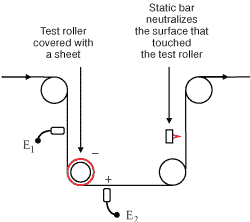How To Measure Charge Performance
- Published: March 01, 2011, By By Dr. Kelly Robinson Contributing Editor
Each product that runs in an operation has its own unique formulation. When a new product is introduced or when the formulation of an existing product is changed, static performance should be evaluated.
For example, when high levels of static are measured on a winding roll, we must determine the source of the charging. The following are three possible sources:

- Formulation Static | The unique formulation makes the product more prone to static.
- Process Static | The static neutralizers installed on the film path do not provide satisfactory static control. The neutralizers should be moved to more effective locations.
- Hot Roll | The incoming roll as received had high static from previous operations.
We need good measurements to guide our decisions. Figure 1 shows one way to measure static charging performance using a sheet of new product. To develop a procedure for measuring the static charging performance, you and your team can start with this procedure and modify it so it works in your operation.
- Select an idler roller in your operation as the test roller.
- The test roller should have a film wrap of at least 90 deg.
- The roller should have easy access for cleaning.
- It must be easy to take fieldmeter measurements on the film spans before and after the roller.
- There should be a downstream static bar neutralizing the film surface that touches the test roller.
- Tape a sheet of the new film around the test roller when the line is down.
- Start running and dedicate about a minute of run time to make the fieldmeter measurements on the film spans before and after the test roller.
- Check the zero on your fieldmeter by measuring the field on a grounded roller or on the machine frame.
- The difference in fieldmeter reading (E2 - E1) measures the static on the film from touching the sheet taped to the test roller.
- Stop running and remove the film sheet from the test roller. Carefully clean the roller to remove all tape adhesive.
- Start running and resume normal operations.
Once you have developed a good procedure for measuring static charging performance, evaluate several good materials that run well in your operation. For a coating operation, be sure to test the charging of the coated surface against the back surface of the film support. Knowing the charging performance of several good materials enables you to make good decisions about the performance of a new formulation.
By measuring static charging, you'll know what static performance to expect from new formulations introduced into your operations. In addition, products may be designed to have good static performance by measuring static charging of several candidate variations. Pick one with good static performance.
I invite you to ask questions about this column and to suggest topics for a future “Static Beat.” My e-mail address is below.
Static control expert Dr. Kelly Robinson, president of Electrostatic Answers, has 27+ years of experience in problem-solving and consulting. Contact him at 585-425-8158; kelly.robinson@electrostaticanswers.com; www.electrostaticanswers.com.












